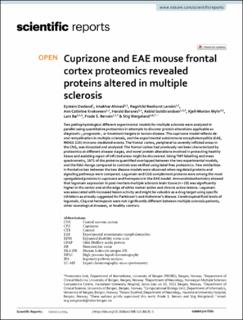| dc.contributor.author | Oveland, Eystein | |
| dc.contributor.author | Ahmad, Intakhar | |
| dc.contributor.author | Lereim, Ragnhild Reehorst | |
| dc.contributor.author | Kroksveen, Ann Cathrine | |
| dc.contributor.author | Barsnes, Harald | |
| dc.contributor.author | Guldbrandsen, Astrid | |
| dc.contributor.author | Myhr, Kjell-Morten | |
| dc.contributor.author | Bø, Lars | |
| dc.contributor.author | Berven, Frode Steingrimsen | |
| dc.contributor.author | Wergeland, Stig | |
| dc.date.accessioned | 2024-01-22T10:41:45Z | |
| dc.date.available | 2024-01-22T10:41:45Z | |
| dc.date.created | 2021-08-31T12:59:12Z | |
| dc.date.issued | 2021 | |
| dc.identifier.issn | 2045-2322 | |
| dc.identifier.uri | https://hdl.handle.net/11250/3113045 | |
| dc.description.abstract | Two pathophysiological different experimental models for multiple sclerosis were analyzed in parallel using quantitative proteomics in attempts to discover protein alterations applicable as diagnostic-, prognostic-, or treatment targets in human disease. The cuprizone model reflects de- and remyelination in multiple sclerosis, and the experimental autoimmune encephalomyelitis (EAE, MOG1-125) immune-mediated events. The frontal cortex, peripheral to severely inflicted areas in the CNS, was dissected and analyzed. The frontal cortex had previously not been characterized by proteomics at different disease stages, and novel protein alterations involved in protecting healthy tissue and assisting repair of inflicted areas might be discovered. Using TMT-labelling and mass spectrometry, 1871 of the proteins quantified overlapped between the two experimental models, and the fold change compared to controls was verified using label-free proteomics. Few similarities in frontal cortex between the two disease models were observed when regulated proteins and signaling pathways were compared. Legumain and C1Q complement proteins were among the most upregulated proteins in cuprizone and hemopexin in the EAE model. Immunohistochemistry showed that legumain expression in post-mortem multiple sclerosis brain tissue (n = 19) was significantly higher in the center and at the edge of white matter active and chronic active lesions. Legumain was associated with increased lesion activity and might be valuable as a drug target using specific inhibitors as already suggested for Parkinson’s and Alzheimer’s disease. Cerebrospinal fluid levels of legumain, C1q and hemopexin were not significantly different between multiple sclerosis patients, other neurological diseases, or healthy controls. | en_US |
| dc.language.iso | eng | en_US |
| dc.publisher | Nature Research | en_US |
| dc.rights | Navngivelse 4.0 Internasjonal | * |
| dc.rights.uri | http://creativecommons.org/licenses/by/4.0/deed.no | * |
| dc.title | Cuprizone and EAE mouse frontal cortex proteomics revealed proteins altered in multiple sclerosis | en_US |
| dc.type | Journal article | en_US |
| dc.type | Peer reviewed | en_US |
| dc.description.version | publishedVersion | en_US |
| dc.rights.holder | Copyright 2021 the authors | en_US |
| dc.source.articlenumber | 7174 | en_US |
| cristin.ispublished | true | |
| cristin.fulltext | original | |
| cristin.fulltext | original | |
| cristin.qualitycode | 1 | |
| dc.identifier.doi | 10.1038/s41598-021-86191-5 | |
| dc.identifier.cristin | 1930079 | |
| dc.source.journal | Scientific Reports | en_US |
| dc.relation.project | Norges forskningsråd: 251235 | en_US |
| dc.identifier.citation | Scientific Reports. 2021, 11, 7174. | en_US |
| dc.source.volume | 11 | en_US |

